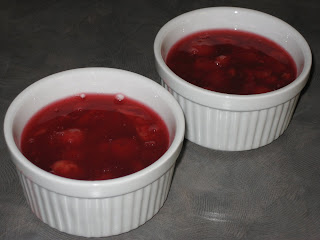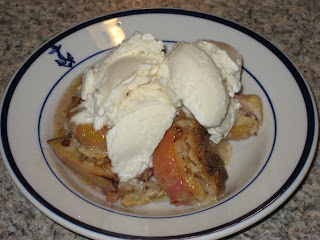
Could a single meal have changed the entire course of America's culinary history? If any meal can be said to have been so momentous, surely it would have to be the meal that Paul and Julia Child shared at a small restaurant in Rouen upon their arrival in France on November 3, 1948. It was during that meal that Julia's lifelong passion for French cooking--the passion that she shared with generations of chefs and home cooks through her books and television shows--was born. And the dish that sparked the fire that's been burning brightly in kitchens everywhere for the past sixty years? This recipe* for Sole Meunière, which Julia called "an opening up of the soul and spirit for me."

Since that meal was where it all began for Julia, it is fitting that the new film,
Julie & Julia starts there, too, with a wide-eyed Julia breathlessly exclaiming "Butter!" as the opening credits roll. The movie opened this weekend, and I didn't waste a minute in getting to see it. More about the movie in a moment, but first, let's keep talking about food. I thought that it was only fitting to mark the occasion of the movie opening by eating, what else? Sole Meunière. According to The Book (the Gourmet Cookbook, that is, and not MtAoFC),
meunière means "miller's wife," and refers to anything dusted in flour. And that's exactly what this dish is: a fillet of sole, dusted in flour, sauteed in butter and parsley, and topped with a butter and lemon juice sauce.

The first step in making Sole Meunière is obtaining the said sole. Without a doubt, the sole that Julia ate at Rouen in 1948 was a
Dover sole. Unfortunately, Dover sole is a European fish that is hard to find in the United States. And while The Book says that it's worth seeking out the real McCoy for this recipe, it also says that gray sole or lemon sole are acceptable alternatives. I was able to find some gray sole at
Hometown Seafoods in Andover, and that was good enough for me. The Book calls for two six ounce fillets for two people. The fillets at Hometown were much smaller, and so I got four fillets totaling twelve ounces.
The rest of the recipe couldn't be easier. I patted the fillets dry and dredged them in some flour. Then I heated three tablespoons of butter on medium-high heat until it started to brown. Next, I added some chopped parsley and shook the pan for just a few seconds to distribute the sizzling parsley throughout the golden butter. I added the sole, and lowered the heat slightly, I cooked it for just a couple of minutes on each side, turning it
very carefully with two spatulas (it's very delicate). When the fish was golden-colored and slightly crisped at the edges, I transferred it to a plate. Finally, I added some more butter, lemon juice and salt to the pan and cooked it for just a few seconds before pouring it over the sole.
So, how was it? It was really, really good. The fish was light and flaky, with just a bit of crispiness. The sauce was buttery without being heavy. Browning the butter gives it a sweet and nutty flavor, while the touch of lemon brightens the sauce and cuts the richness of the butter. There's nothing "extra" or fancy in this dish. Just a couple of simple ingredients combined so perfectly together to make a truly sublime, yet uncomplicated dish. In MtAoFC, Julia refers to
Potage Parmentier (Leek and Potato Soup) as "simplicity itself." Sole Meunière could be described in the same way, and it's no surprise that this dish was an eye-opening experience for Julia.
Now, the movie. It was everyting I hoped it would be. Meryl Streep is amazing. She's not so much "playing" Julia Child as she is channeling her. My money is on her for a Best Actress Oscar. But, with all of the fawning over Meryl and Julia, I think that
the critics have been unfair to Julie Powell. As a cook-through blogger, I'm biased, but I can't help but feel the need to come to Julie's defense when the
New York Times places all of the blame for the movie's few shortcomings squarely on Julie's shoulders. The Times calls Julie's book "rambling," and says that "the deck is stacked against" Amy Adams, who plays Julie because of "the discrepancy between Ms. Powell’s achievement and Ms. Child’s." Ouch! Even Judith Jones (Julia's editor, who
stood Julie up on a dinner invitation during the Julie/Julia Project, by the way) is
talking smack about Julie. Judith told Publisher's Weekly that Julia didn't want to "endorse" Julie's project because she thought it was a "stunt" undertaken by someone who wasn't a "serious cook." Courage, Julie! There are an
enlightened few of us who understand what it was that you were trying to accomplish, and we appreciate your efforts. Don't listen to the haters.

One last point about the movie. At it's core, its a love story. There's the love affair we all have with food, of course. But, this movie is really about two couples who love, support, and understand one another. Without Paul Child and Eric Powell, there wouldn't be a Julia Child or a Julie Powell. This film was a wonderful reminder to me of just how lucky I am to have found someone who is, as Paul said of Julia, "the butter to my bread and the breath to my life."
Date Cooked: August 8, 2009
Degree of Difficulty: Easy
Rating: A-
*This recipe isn't on epicurious.com, and, strangely enough, it's not in Mastering the Art of French Cooking, either. Curious that Julia didn't include the dish that started it all in her classic book. Julia's recipe for Sole Meunière, does appear, however, in
Julia's Kitchen Wisdom, and was recently reprinted in
The Chicago Tribune.
 When I made the Sour Cherry Crostata for the Fourth of July, I felt bad that my wife couldn't eat it because of the flour and butter. I decided to make it up to her by making this recipe* for Chilled Sour Cherry Soup so that she could enjoy all of the great cherry flavor without any of that pesky dairy and gluten.
When I made the Sour Cherry Crostata for the Fourth of July, I felt bad that my wife couldn't eat it because of the flour and butter. I decided to make it up to her by making this recipe* for Chilled Sour Cherry Soup so that she could enjoy all of the great cherry flavor without any of that pesky dairy and gluten.













